ADATA XPG V2 Review: 2x8 GB at DDR3-2400 C11-13-13 1.65 V
by Ian Cutress on November 11, 2013 1:00 PM ESTIGP Compute
One of the touted benefits of Haswell is the compute capability afforded by the IGP. For anyone using DirectCompute or C++ AMP, the compute units of the HD 4600 can be exploited as easily as any discrete GPU, although efficiency might come into question. Shown in some of the benchmarks below, it is faster for some of our computational software to run on the IGP than the CPU (particularly the highly multithreaded scenarios).
Grid Solvers - Explicit Finite Difference on IGP
As before, we test both 2D and 3D explicit finite difference simulations with 2n nodes in each dimension, using OpenMP as the threading operator in single precision. The grid is isotropic and the boundary conditions are sinks. We iterate through a series of grid sizes, and results are shown in terms of ‘million nodes per second’ where the peak value is given in the results – higher is better.
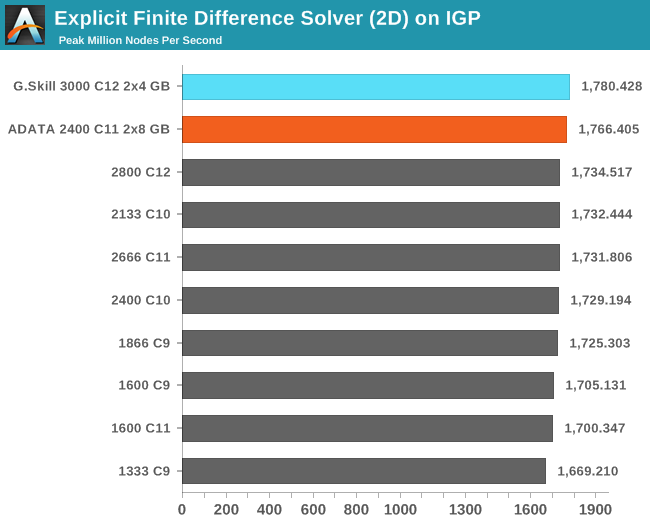
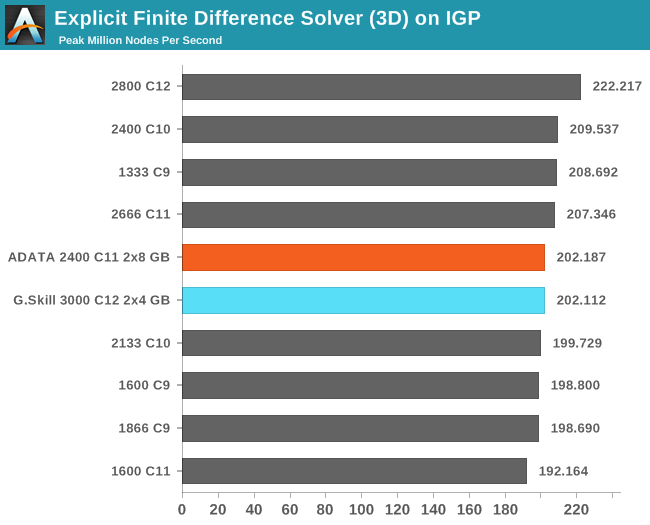
N-Body Simulation on IGP
As with the CPU compute, we run a simulation of 10240 particles of equal mass - the output for this code is in terms of GFLOPs, and the result recorded was the peak GFLOPs value.
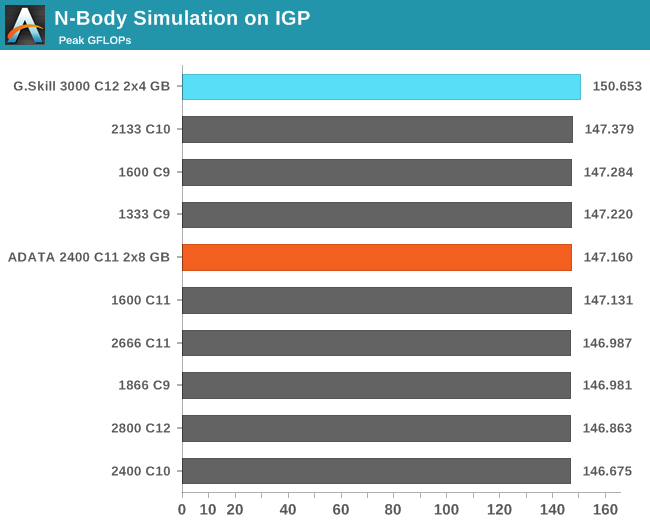
3D Particle Movement on IGP
Similar to our CPU Compute algorithm, we calculate the random motion in 3D of free particles involving random number generation and trigonometric functions. For this application we take the fastest true-3D motion algorithm and test a variety of particle densities to find the peak movement speed. Results are given in ‘million particle movements calculated per second’, and a higher number is better.
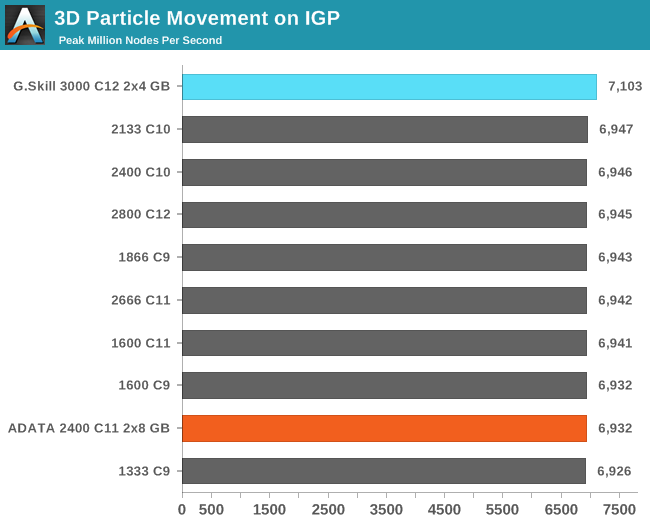
Matrix Multiplication on IGP
Matrix Multiplication occurs in a number of mathematical models, and is typically designed to avoid memory accesses where possible and optimize for a number of reads and writes depending on the registers available to each thread or batch of dispatched threads. He we have a crude MatMul implementation, and iterate through a variety of matrix sizes to find the peak speed. Results are given in terms of ‘million nodes per second’ and a higher number is better.
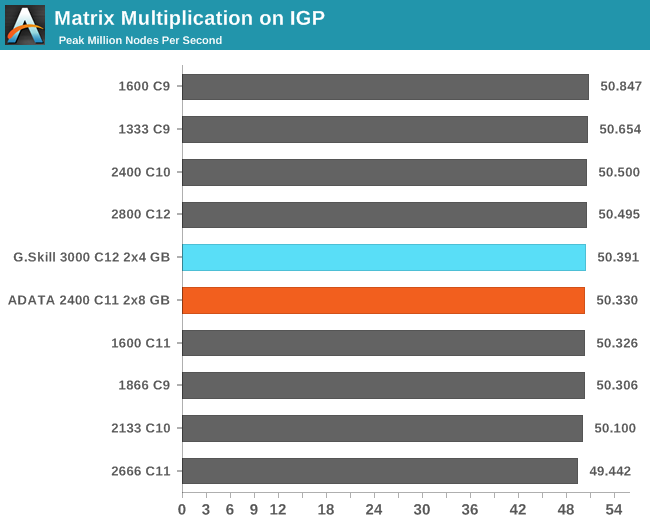










23 Comments
View All Comments
Rick83 - Monday, November 11, 2013 - link
So running memory on a 22nm CPU at 1.65 volts (or more, for the OC) has suddenly become acceptable again? Last I heard everyone clamoring to only get 1.5V memory, so as not to fry the IMC before its time.At $200, the key point is that by taking a $100 kit and putting those $100 dollars toward more memory or toward extra CPU performance would probably be better. Going with IB-E instead of with Haswell could probably done with that extra money - and you get double the memory channels to play with as a result.
IanCutress - Monday, November 11, 2013 - link
Most DDR3 memory past 1866 C9 is at 1.65 volts. These IMCs are sturdy enough, almost all will take 2x8 GB 2933 C12 without breaking a sweat. When did it ever become unacceptable? I've never seen any issues except taking Sandy above 2400 MHz, because the IMC wasn't particularly built for it. Ivy kicked it up a notch and Haswell accepts most of what I throw at it as long as you're reasonable and the memory itself can handle it.owan - Monday, November 11, 2013 - link
There was a LOT of talk when SB released about using 1.5v ram instead of 1.65v due to the IMC supposedly not tolerating higher voltages well. I don't know how true it was, but I thought this was common knowledge.hoboville - Monday, November 11, 2013 - link
Yes, there has been (and still is concern) that over-volting RAM can have a negative impact on the memory controller, because it is on the CPU die. RAM voltages and power do have an impact on the memory controller, of that there is no doubt. In fact, Registered Memory (also known as Fully Buffered or just Buffered Memory) was a design that came about when the IMC had to interface with large amounts of RAM (and power), particularly servers where 8+ slots is not uncommon.http://en.wikipedia.org/wiki/Registered_memory
The Von Matrices - Monday, November 11, 2013 - link
Well, according to Intel (http://www.intel.com/support/processors/sb/CS-0299..."Intel recommends using memory that adheres to the Jedec memory specification for DDR3 memory which is 1.5 volts, plus or minus 5%. Anything more than this voltage can damage the processor or significantly reduce the processor life span."
However, I have not seen anyone who had a processor fail explicitly due to 1.65V memory. Granted, this might be hard to tell because many of the failed processors with 1.65V memory also have core overclocking and overvolting, and separating the actual cause of failure is impossible without an electron microscope.
I run my Hawswell system at 1.65V DDR3-2400, and I am not worried about 1.65V killing the processor. What's more concerning to me is that my Mushkin Blackline memory's XMP profile adjusts the system agent voltage +0.3V, which is far too much for me. I forced it back to default voltage and the memory works fine.
jabber - Tuesday, November 12, 2013 - link
It may be that Intel's research determined that running at 1.65v could reduce the life of the CPU from 30 years to 28 years.freedom4556 - Tuesday, November 12, 2013 - link
Yeah, I love that there is a huge difference between the statistical and colloquial meaning of the word "significant" that always seems to be abused by marketers and misused by media.kishorshack - Monday, November 11, 2013 - link
This is an Anandtech Reviewhoboville - Monday, November 11, 2013 - link
A quick suggestion: could you do a ranking of performance index as related to price, displaying performance per dollar?For gamers, the biggest point is how much time the GPU spends asking the RAM for data. Games that are more heavily CPU bound will probably see some benefit from faster RAM. It is worth noting that Dirt 3 seems to benefit the most from lower timings, as the lowest timings see the highest FPS. Undoubtedly, each GPU is waiting for information from RAM, and in turn, longer RAM latency means that each GPU has to wait for its chunk of data. Better titles will rely less on CPU and more on GPU, maybe Mantle will have some effect on this with reduced draw calls?
Anyway, the price scaling on these "performance" RAM is so large that I couldn't in good conscience ever recommend anyone buying them when they would be better off spending it on a: dGPU, better dGPU, second dGPU.
freedom4556 - Monday, November 11, 2013 - link
"Games that are more heavily CPU bound will probably see some benefit from faster RAM."Not according to nearly every review I've ever read on memory. Most reviews have all results within about 5 fps of each other regardless of game. Only synthetics really benefit. See articles like:
http://anandtech.com/show/7364/memory-scaling-on-h...
http://www.techpowerup.com/reviews/Avexir/Core_Ser...
http://www.tomshardware.com/reviews/low-voltage-dd...